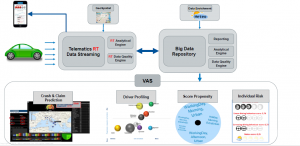The Internet of Things (IoT) is drastically changing our lives, whether this is at home, in the car, at work or even in the street. Gartner has predicted that by 2020, 20.8 billion devices will be connected. Moreover, the potential economic impact of IoT by 2025 is estimated to be $11 Trillion, which corresponds to 11% of world economy.

Vehicles are well on their ways to becoming the most sophisticated mobile devices in the IoT or, to use a phrase that is more to the point, the Monetization of Things™ (MoT). Linked to the cloud by wireless technologies, mobile apps, smart chips and onboard computers, connected vehicles are driving new business models and disrupting old ones. The Internet of Things, connected mobility, telematics and the autonomous car are collectively driving insurance carriers to re-think their business.
How insurers are looking beyond premiums
Take the example of transportation service providers. Increasing driver safety, asset yield and capacity/routing optimization are all ways to monetize IoT. As this video illustrates, onboard telematics can provide significant efficiencies and augment the effectiveness of the driver, and support services that assist the driver.
In-vehicle sensors offer a number of Value-Added Services (VAS) that go beyond the immediate benefits to the insurance industry (see Figure below):
- Based on their driving profile and real risk factor, insurers can offer personalized and fair policies to customers;
- Car manufacturers can include functionality to monitor and alert drivers of the need for repairs;
- Since speeding is one of the leading cause of car accidents, the system would also contribute to overall road safety. The technology can contribute to ongoing education of drivers via alerts about excessive speeding or insufficient braking space, leading to efficient crash and claim prediction services.

Seeing is believing
So how expensive it is going to be to implement such capabilities? We have seen examples of insurance companies working together with fleet managers to gain huge benefits by tuning existing analytics capabilities.
The following demo about Connected Cars has been built using SAS Event Stream Processing, a solution for Streaming Analytics. By using a driving simulator it is possible to set some parameters, such as:
- Vehicle identifier;
- Speed;
- Type of road you are currently traveling (highway or town) detected by GPS.
Moreover, by clicking on the arrows it is possible to change the car's direction. The simulator shows a summary sentence of what is going on, such as "You are turning right in the city", and, according to road safety policies, notifications are shown in real-time on the driver’s smartphone.
Beyond the safety and efficiency factors, there is also the possibility of integrating loyalty and retention facets. For example, if a driver has bene on the road, it will be possible to suggest the nearest coffee stops for a break.
The ecosystem factor
Clearly automotive players are charging ahead with smarter vehicles so all drivers have better information available to them. Insurance companies can gain market share by aligning risk to discounts with better insights. Fleet managers can affect some improvement by equipping themselves with analytics that can tune driver and support performances. But we see potential for a quantum leap in monetization when these three parties come together to offer drivers a more holistic experience, and financial reward.
Are you looking to engage with your ecosystem partners to drive better monetization of IoT? I’d love to hear how you are driving these initiatives!
If you want to know more on this topic, take a look at this white paper:
Telematics: How Big Data Is Transforming the Auto Insurance Industry


5 Comments
Pingback: Data ops: Better way to prepare data for analytics and IoT? - The Data Roundtable
Pingback: Internet of Things: Fitnesstest für Data Operations - Mehr Wissen
Pingback: Monetizing data from the IoT - SAS Voices
Pingback: Ahead of the IoT curve? - Hidden Insights
Pingback: Is data science keep pace with product designers needs?